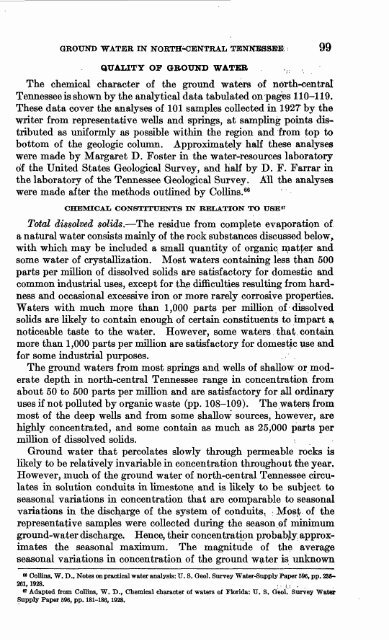GROUND WATER IN NORTH-CENTRAL TENNESSEE
GROUND WATER IN NORTH-CENTRAL TENNESSEE
GROUND WATER IN NORTH-CENTRAL TENNESSEE
You also want an ePaper? Increase the reach of your titles
YUMPU automatically turns print PDFs into web optimized ePapers that Google loves.
<strong>GROUND</strong> "<strong>WATER</strong> <strong>IN</strong> <strong>NORTH</strong>-<strong>CENTRAL</strong> <strong>TENNESSEE</strong>;: 99<br />
QUALITY OF <strong>GROUND</strong> <strong>WATER</strong> ,,. ,<br />
The chemical character of the ground waters of north-central<br />
Tennessee is shown by the analytical data tabulated on pages 110-119.<br />
These data cover the analyses of 101 samples collected in 1927 by the<br />
writer from representative wells and springs, at sampling points dis<br />
tributed as uniformly as possible within the region and from top to<br />
bottom of the geologic column. Approximately half these analyses<br />
were made by Margaret D. Foster in the water-resources laboratory<br />
of the United States Geological Survey, and half by D. F. Farrar in<br />
the laboratory of the Tennessee Geological Survey. All the analyses<br />
were made after the methods outlined by Collins. 66<br />
CHEMICAL CONSTITUENTS <strong>IN</strong> RELATION TO USE"<br />
Total dissolved solids. The residue from complete evaporation of<br />
a natural water consists mainly of the rock substances discussed below,,<br />
with which may be included a small quantity of organic matter and<br />
some water of crystallization. Most waters containing less than 500<br />
parts per million of dissolved solids are satisfactory for domestic and<br />
common industrial uses, except for the difficulties resulting from hard<br />
ness and occasional excessive iron or more rarely corrosive properties.<br />
Waters with much more than 1,000 parts per million of dissolved<br />
solids are likely to contain enough of certain constituents to impart a,<br />
noticeable taste to the water. However, some waters that, contain<br />
more than 1,000 parts per million are satisfactory for domestic use and<br />
for some industrial purposes. .<br />
The ground waters from most springs and wells of shallow or mod<br />
erate depth in north-central Tennessee range in concentration from<br />
about 50 to 500 parts per million and are satisfactory for all ordinary<br />
uses if not polluted by organic waste (pp. 108-109). The waters from<br />
most of the deep wells and from some shallow sources, however, are<br />
highly concentrated, and some contain as much as 25,000 parts per<br />
million of dissolved solids. ;<br />
Ground water that percolates slowly through permeable rocks is<br />
likely to be relatively invariable in concentration throughout the year.<br />
However, much of the ground water of north-central Tennessee circu<br />
lates in solution conduits in limestone and is likely to be subject to<br />
seasonal variations in concentration that are comparable to seasonal<br />
variations in the discharge of the system of conduits. ; Mos,t of the<br />
representative samples were collected during the season of minimum<br />
ground-water discharge. Hence, their concentration probably, approx<br />
imates the seasonal maximum. The magnitude of the average<br />
seasonal variations in concentration of the ground water is unknown<br />
M Oollins, W. D., Notes on practical water analysis: U. S. Geol. Survey Water-Supply Paper 596, pp. 236-<br />
261, 1928. ., ,. , .<br />
u Adapted from Collins, W. D., Chemical character of waters of Florida: TJ. S. Geol. Survey Water<br />
Supply Paper 596, pp. 181-186,1928.

















